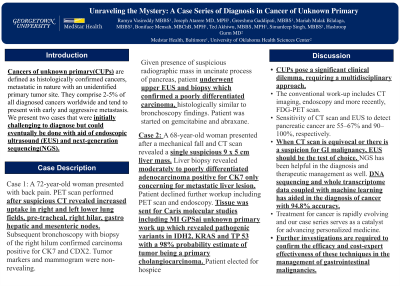Monday Poster Session
Category: Biliary/Pancreas
P1859 - Unraveling the Mystery: A Case Series of Diagnosis in Cancer of Unknown Primary
Monday, October 28, 2024
10:30 AM - 4:00 PM ET
Location: Exhibit Hall E

Has Audio

Ramya Vasireddy, MBBS
MedStar Union Memorial Hospital
Baltimore, MD
Presenting Author(s)
Ramya Vasireddy, MBBS1, Joseph Atarere, MD, MPH1, Greeshma Gaddipati, MBBS1, Mariah Malak Bilalaga, MBBS1, Boniface Mensah, MBChB, MPH1, Ted Akhiwu, MBBS, MPH1, Simardeep Singh, MBBS1, Hashroop Gurm, MD2
1MedStar Union Memorial Hospital, Baltimore, MD; 2University of Oklahoma Health Sciences Center, Oklahoma City, OK
Introduction: Cancers of unknown primary(CUPs) are defined as histologically confirmed cancers, metastatic in nature with an unidentified primary tumor site. They comprise 2-5% of all diagnosed cancers worldwide and tend to present with early and aggressive metastasis. We present two cases that were initially challenging to diagnose but could eventually be done with aid of endoscopic ultrasound (EUS) and next-generation sequencing(NGS).
Case Description/Methods: Case 1: A 72 year old woman presented with back pain. PET scan performed after suspicious CT revealed increased uptake in right and left lower lung fields, pretracheal, right hilar, gastrohepatic and mesenteric nodes. Subsequent bronchoscopy with biopsy of the right hilum confirmed carcinoma positive for CK7 and CDX2. Tumor markers and mammogram were non revealing. Given presence of suspicious radiographic mass in uncinate process of pancreas, patient underwent upper EUS and biopsy which confirmed a poorly differentiated carcinoma, histologically similar to bronchoscopy findings. Patient was started on gemcitabine and abraxane.
Case 2: A 68 year old woman presented after a mechanical fall and CT scan revealed a single suspicious 9 x 5 cm liver mass. Liver biopsy revealed moderately to poorly differentiated adenocarcinoma positive for CK7 only concerning for metastatic liver lesion. Patient declined further workup including PET scan and endoscopy. Tissue was sent for Caris molecular studies including MI GPSai unknown primary work up which revealed pathogenic variants in IDH2, KRAS and TP 53 with a 98% probability estimate of tumor being a primary cholangiocarcinoma. Patient elected for hospice care.
Discussion: CUPs pose a significant clinical dilemma, requiring a multidisciplinary approach. The conventional work-up includes CT imaging, panendoscopy and more recently, FDG-PET scan. Sensitivity of CT scan and EUS to detect pancreatic cancer are 55–67% and 90–100%, respectively. When CT scan is equivocal or there is a suspicion for GI malignancy, EUS should be the test of choice. NGS has been helpful in the diagnosis and therapeutic management as well. DNA sequencing and whole transcriptome data coupled with machine learning has aided in the diagnosis of cancer with 94.8% accuracy. Treatment for cancer is rapidly evolving and our case series serves as a catalyst for advancing personalized medicine. Further investigations are required to confirm the efficacy and cost-effectiveness of these techniques in the management of gastrointestinal malignancies.
Disclosures:
Ramya Vasireddy, MBBS1, Joseph Atarere, MD, MPH1, Greeshma Gaddipati, MBBS1, Mariah Malak Bilalaga, MBBS1, Boniface Mensah, MBChB, MPH1, Ted Akhiwu, MBBS, MPH1, Simardeep Singh, MBBS1, Hashroop Gurm, MD2. P1859 - Unraveling the Mystery: A Case Series of Diagnosis in Cancer of Unknown Primary, ACG 2024 Annual Scientific Meeting Abstracts. Philadelphia, PA: American College of Gastroenterology.
1MedStar Union Memorial Hospital, Baltimore, MD; 2University of Oklahoma Health Sciences Center, Oklahoma City, OK
Introduction: Cancers of unknown primary(CUPs) are defined as histologically confirmed cancers, metastatic in nature with an unidentified primary tumor site. They comprise 2-5% of all diagnosed cancers worldwide and tend to present with early and aggressive metastasis. We present two cases that were initially challenging to diagnose but could eventually be done with aid of endoscopic ultrasound (EUS) and next-generation sequencing(NGS).
Case Description/Methods: Case 1: A 72 year old woman presented with back pain. PET scan performed after suspicious CT revealed increased uptake in right and left lower lung fields, pretracheal, right hilar, gastrohepatic and mesenteric nodes. Subsequent bronchoscopy with biopsy of the right hilum confirmed carcinoma positive for CK7 and CDX2. Tumor markers and mammogram were non revealing. Given presence of suspicious radiographic mass in uncinate process of pancreas, patient underwent upper EUS and biopsy which confirmed a poorly differentiated carcinoma, histologically similar to bronchoscopy findings. Patient was started on gemcitabine and abraxane.
Case 2: A 68 year old woman presented after a mechanical fall and CT scan revealed a single suspicious 9 x 5 cm liver mass. Liver biopsy revealed moderately to poorly differentiated adenocarcinoma positive for CK7 only concerning for metastatic liver lesion. Patient declined further workup including PET scan and endoscopy. Tissue was sent for Caris molecular studies including MI GPSai unknown primary work up which revealed pathogenic variants in IDH2, KRAS and TP 53 with a 98% probability estimate of tumor being a primary cholangiocarcinoma. Patient elected for hospice care.
Discussion: CUPs pose a significant clinical dilemma, requiring a multidisciplinary approach. The conventional work-up includes CT imaging, panendoscopy and more recently, FDG-PET scan. Sensitivity of CT scan and EUS to detect pancreatic cancer are 55–67% and 90–100%, respectively. When CT scan is equivocal or there is a suspicion for GI malignancy, EUS should be the test of choice. NGS has been helpful in the diagnosis and therapeutic management as well. DNA sequencing and whole transcriptome data coupled with machine learning has aided in the diagnosis of cancer with 94.8% accuracy. Treatment for cancer is rapidly evolving and our case series serves as a catalyst for advancing personalized medicine. Further investigations are required to confirm the efficacy and cost-effectiveness of these techniques in the management of gastrointestinal malignancies.
Disclosures:
Ramya Vasireddy indicated no relevant financial relationships.
Joseph Atarere indicated no relevant financial relationships.
Greeshma Gaddipati indicated no relevant financial relationships.
Mariah Malak Bilalaga indicated no relevant financial relationships.
Boniface Mensah indicated no relevant financial relationships.
Ted Akhiwu indicated no relevant financial relationships.
Simardeep Singh indicated no relevant financial relationships.
Hashroop Gurm indicated no relevant financial relationships.
Ramya Vasireddy, MBBS1, Joseph Atarere, MD, MPH1, Greeshma Gaddipati, MBBS1, Mariah Malak Bilalaga, MBBS1, Boniface Mensah, MBChB, MPH1, Ted Akhiwu, MBBS, MPH1, Simardeep Singh, MBBS1, Hashroop Gurm, MD2. P1859 - Unraveling the Mystery: A Case Series of Diagnosis in Cancer of Unknown Primary, ACG 2024 Annual Scientific Meeting Abstracts. Philadelphia, PA: American College of Gastroenterology.
